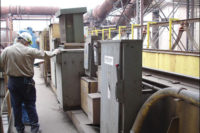| Arc Flash |
|
Obsolete arc flash protective clothing and PPE |
Ralph Lee wrote a series of papers for the IEEE on the three hazards of electricity and developed the first equations for determining incident energy. Mr. Lee’s work began to draw some attention within the industry to hazards other than electrical shock.
In the late 1980s, the first arc flash suits began to appear. Most were made from double-layer 6 oz/yd2 NOMEX® and used polycarbonate (plastic) windows. This equipment was considered state-of-the-art, until 1996 when arc testing of clothing and PPE began.
It was soon discovered that the existing PPE and clothing were inadequate, especially for higher values of incident energy. Arc flash testing found that the polycarbonate windows would actually fail at a very low value of incident energy, causing the window to melt. Figures 1a and 1b show an example of early, unrated arc flash PPE and clothing.
One way to tell the arc flash protective equipment is inadequate is its clear face shield that has no arc rating. The other is the lack of required markings (ATPV, ASTM F1506 and NFPA 70E) on the label.
Obsolete arc flash protective clothing and PPE
Unfortunately, this type of flash suit is still used by uninformed technicians and contractors who purchased them many years ago and hate to waste money by buying new arc-rated PPE.
All arc flash protective clothing and PPE must have a label showing the arc rating and that it complies with ASTM F1506 and NFPA 70E. Unrated arc flash clothing and PPE presents a very real threat to the user’s well-being and the person wearing it must not be allowed to work on or near any electrical power system or device that may be energized. Be aware that there are arc-rated flash suits that have a similar appearance but meet the requirements above. These would be sufficient to perform tasks on or near energized conductors and circuit parts.
Injury from an electrical arc flash
Five primary factors determine the severity of an injury from an electrical arc:
- Distance from the arc
- Absorption coefficient of the clothing worn
- Arc temperature
- Arc duration
- Arc length
- Distance from the arc
The heat of an electrical arc is referred to as the “incident energy”. This is because the heat is made up of the radiated heat (infrared) and convection heat (heat flow through air). Incident energy decreases by the inverse square of the distance.
In simpler terms, as a person moves away from an arc, the heat will decrease rapidly. This aspect is critical to understanding how to protect oneself from an arc. Consider body position when performing energized work. A person should stand as far from the device as possible while still being able to perform the work effectively. Standing closer than necessary will increase the incident energy that person will receive if there is an arc flash event. The standard working distance for <600V is typically 18 inches, while 2.4kV to 15kV power systems usually have a 36-inch working distance.
Coefficient of clothing worn
Type and fabric weight of clothing being worn affects the heat that is transferred to the body. NFPA 70E recommends wearing either flammable, non-melting clothing as underlayers (cotton, wool or silk) or arc-rated underlayers for additional protection. Generally, each layer of clothing under arc-rated reduces heat to the body by approximately 50 percent. Flammable underlayers do not increase the arc rating of a clothing system but will reduce the probability of a burn underneath arc-rated clothing.
Arc temperature
Temperature of an electrical arc is mostly determined by the megawatts power being consumed by the arc. Megawatts (watts x 1,000,000) may seem like a tremendous amount of energy, but a three-phase 480V fault with 50,000A of short circuit current will consume 23 MW of power!
Arc duration
Arc duration is the second most-critical factor in an arc flash event. Incident energy is proportional to time. If a person is exposed to an arc flash for 0.08 seconds, they would receive twice the incident energy as an arc of the same magnitude that lasted 0.04 seconds. This is why the NFPA 70E Technical Committee inserted Section 205.4 which states, “Overcurrent protective devices shall be maintained in accordance with the manufacturers’ instructions or industry consensus standards.” Poorly-maintained circuit breakers and other OCPD are unreliable. If an OCPD malfunctions, it will increase the time it takes to clear and extinguish the fault. Consult NFPA 70B and ANSI/NETA MTS-2011 to develop an acceptable maintenance program.
Arc length
Arc length becomes a factor at higher voltages (>600V). It has been demonstrated that, with all other factors being the same, a longer arc creates more incident energy than a shorter arc. Low-voltage power systems cannot sustain a longer electrical arc, as arc resistance causes a voltage drop of approximately 75 to 100V/inch.
Current-limiting devices: Not a cure-all
Current-limiting fuses are an effective method of reducing both incident energy and potential pressure wave by limiting available short circuit current from the system and greatly reducing the duration of the arc (Figure 2). When properly applied, current-limiting fuses have a clearing time of less than ½ cycle. Current-limiting fuses cannot be applied in all circumstances and, if the short circuit current does not push the fuse into its current-limiting region, it will act as a dual-element time delay fuse. Some manufacturers produce current-limiting circuit breakers for low-voltage protection, and they have similar short-circuit characteristics as current-limiting fuses.



